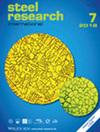On the Role of Tramp Elements for Surface Defect Formation in Continuous Casting of Steel
IF 1.9
3区 材料科学
Q2 METALLURGY & METALLURGICAL ENGINEERING
引用次数: 0
Abstract
In the course of the decarbonization of steel production, electric steel production will continue to gain importance. The processing of low‐quality scrap will also play an important role, which may lead to an increase in the content of so‐called tramp elements in steel production and further processing. This article examines the effect of the elements Cu, Sn, and Ni on the formation of surface cracks under the conditions of the continuous casting process. Results of an in situ bending test are compared with the results of the experimental simulation of high‐temperature oxidation and thermodynamic analysis based on the CALculation of PHase Diagrams (CALPHAD) approach. For a temperature of 900 °C, an equivalent Cu content of 0.20 wt% must be considered as the critical upper limit. The presumable reason is the existence of Cu‐ and Sn‐rich liquid phases at the austenite grain boundaries. The results clearly show the effect of the investigated elements but also point to the importance of the gas atmosphere and cooling conditions on the results. This can be a groundbreaking result for extending the process window for casting steels with increased tramp element contents.论连铸钢件表面缺陷形成过程中杂质的作用
在钢铁生产去碳化的过程中,电炉钢生产将继续占据重要地位。劣质废钢的加工也将发挥重要作用,这可能导致钢铁生产和深加工中所谓杂质元素含量的增加。本文研究了铜、锡和镍元素在连铸工艺条件下对表面裂纹形成的影响。原位弯曲试验结果与高温氧化实验模拟结果以及基于相图计算(CALPHAD)方法的热力学分析结果进行了比较。对于 900 °C 的温度,必须将 0.20 wt% 的等效铜含量视为临界上限。原因可能是奥氏体晶界存在富含铜和锡的液相。结果清楚地显示了所研究元素的影响,但也指出了气体环境和冷却条件对结果的重要性。这对于延长杂散元素含量增加的铸钢的工艺窗口来说,可能是一个突破性的结果。
本文章由计算机程序翻译,如有差异,请以英文原文为准。
求助全文
约1分钟内获得全文
求助全文
来源期刊

steel research international
工程技术-冶金工程
CiteScore
3.30
自引率
18.20%
发文量
319
审稿时长
1.9 months
期刊介绍:
steel research international is a journal providing a forum for the publication of high-quality manuscripts in areas ranging from process metallurgy and metal forming to materials engineering as well as process control and testing. The emphasis is on steel and on materials involved in steelmaking and the processing of steel, such as refractories and slags.
steel research international welcomes manuscripts describing basic scientific research as well as industrial research. The journal received a further increased, record-high Impact Factor of 1.522 (2018 Journal Impact Factor, Journal Citation Reports (Clarivate Analytics, 2019)).
The journal was formerly well known as "Archiv für das Eisenhüttenwesen" and "steel research"; with effect from January 1, 2006, the former "Scandinavian Journal of Metallurgy" merged with Steel Research International.
Hot Topics:
-Steels for Automotive Applications
-High-strength Steels
-Sustainable steelmaking
-Interstitially Alloyed Steels
-Electromagnetic Processing of Metals
-High Speed Forming
 求助内容:
求助内容: 应助结果提醒方式:
应助结果提醒方式:


